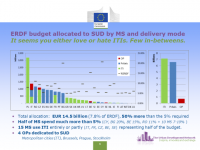
This network article reflects on some reference elements of integrated urban development in the European funding period 2014-20. Under Article 7 new tools of implementation and funding of interlinked actions have been introduced. Managing Authorities (MA) and cities need to act as partners to fulfil the objectives developed in the Operational Programmes. This task leads to an innovative question of multilevel governance and co-operation, based on an analysis of interests of the involved stakeholders in the decision-making processes. The step from planning to implementation and funding with shared responsibilities is a new challenge which the partners of the “Cities in Article 7” (CIA 7) URBACT Implementation Network want to explore together.
The urban dimension of cohesion policy in the programming period 2014-2020 has been strengthened by new instruments in the Operational Programmes for sustainable development in cities. A minimum of 5% of the national ERDF envelope had to be allocated for this purpose with Article 7 of the ERDF regulation N° 1301/2013 (European Commission 2013a, Regulation (EU) 1301/2013 of the European Parliament and of the Council of 17 December 2013 on the European Regional Development Fund and on specific provisions concerning the Investment for growth and jobs goal and repealing, Regulation (EC) No 1080/2006). From a DG REGIO overview, the total allocation is about EUR 14.5 billion which is 7.8% of ERDF. Half of the Member States spend much more than 5% (Matkó, M, Sustainable Urban Development in Cohesion Policy Programmes 2014-2020. An overview. European Commission, DG Regional and Urban Policy, Brussels, 18 February 2016). Many expectations are being raised on these new instruments in terms of efficiency and improvement of the implementation of sustainable and integrated urban policies and practices, also in terms of empowering cities by delegating some MA functions, at least project selection.
The ‘integrated approach’ has become a recurring topic in European cohesion policy developing over more than two decades. The Urban Acquis (The ‚Acquis URBAN’. Using Cities’ Best Practises for European Cohesion Policy. Common Declaration of URBAN cities and players at the European Conference URBAN Future, 8-9 June 2005 in Saarbrücken (Germany), 2005) based on the experiences with the Community Initiative URBAN I (1994-99) and URBAN II (2000-06), the Leipzig Charter on Sustainable Cities (Leipzig Charter on Sustainable Cities, adopted at the Informal Ministerial Meeting on Urban Development and Territorial Cohesion in Leipzig on 24-25 May 2007) and later the Toledo Declaration (Toledo Declaration, adopted at the Informal Ministerial Meeting on the Urban Development Declaration in Toledo on 22 June 2010) laid the ground with the definition of principles of integrated urban development. They initiated and fostered a debate on a stronger role of cities and the needs of integrated urban regeneration in European mainstreaming.
From a European overview five years after adopting the Leipzig Charter emerges a general shift towards integrated approaches, even though still with different speeds and activities. “This can be attributed to the fact that there is no single urban model in Europe – environments, problems and potentials differ not only from country to country, but also from city to city. On top of this, urban policy has a different relevance in the various EU member states, its candidate countries as well as in Norway and Switzerland, and is therefore not supported to the same extent at national level” (BMVBS Federal Ministry of Transport, Building and Urban Development, 5 Years after the Leipzig Charter – Integrated Urban Development as a Prerequisite for a Sustainable City. Integrated Urban Development in the EU Member States and its Candidate Countries, Berlin, 2012, p. 21).
In his 2009 report for the European Commission Fabrizio Barca argued that an integrated territorial (or place-based) approach should be used to revitalise cohesion policy, helping the EU reach its economic and social objectives. “A place-based policy is a long-term strategy aimed at tackling persistent underutilisation of potential and reducing persistent social exclusion in specific places through external interventions and multilevel governance. It promotes the supply of integrated goods and services tailored to contexts, and it triggers institutional changes.” (Barca, F., An Agenda for a Reformed Cohesion Policy. A Place-Based Approach to Meeting European Union Challenges and Expectations, Independent Report prepared at the request of Danuta Hübner, Commissioner for Regional Policy, 2009, p. VII). In the Cities of Tomorrow report the multilevel governance challenges have been further developed: “New relations are being forged between different levels, e.g. between the European and the local levels. The range of actors involved in policy-making and policy shaping needs to be widened to include diverse stakeholders, including citizens. In essence, policies have to operate in a multiscalar governance framework.” (European Commission, Cities of Tomorrow. Challenges, visions, ways forward. GD Regional Policy, Luxemburg, 2011, p. 93)
A place-based approach is challenging because it demands cross-sector and cross-department thinking and acting, at all administrative levels, together with a mixed funding. The outcomes from a study on 50 urban development case studies funded by ERDF in the 2007-13 period stress how „physical regeneration is still a major driver in creating multi-stakeholder cooperation in the integration of policies. However, in the best examples, both people and place-based approaches are combined at relevant administrative levels. This combination of place-based and people-based approaches is most visible in those cases where the national level is committed to developing the two approaches together.” (European Commission 2013b, Urban Development in the EU: 50 Projects Supported by the European Regional Development Fund during the 2007-13 Period. GD Regional Policy and Urban Development, Luxemburg, p. 59)
Main arrangements under Article 7
The new instruments introduced under Article 7 from a multi-level governance perspective want to stimulate this combination from different structural finds. Funding has to be based on sustainable urban development strategies addressing urban challenges and urban rural linkages. Generally, these new instruments under Article 7 have been built and defined top-down. More flexibility to adapt them to the national and regional levels, at the same time requires new responsibilities and capacities of administration and implementation of structural funds at local level. Three main arrangements under Article 7 are possible:
- A specific priority axis of an operational programme dedicated to Sustainable Urban Development
- A specific operational programme dedicated to Sustainable Urban Development
- Integrated Territorial Investments (ITI): a certain part of the financial allocation of one or more priority axes of one or more operational programmes can be implemented through ITIs
What can be observed from the first practice reports is a broad range of applying Article 7 in different national contexts. There is not one simple and singular way of implementation due to the variety of framework conditions. For instance, there are only 4 specific Operational Programmes, the national Metropolitan Areas Programme (PON Metro) in Italy and three capital cities (Brussels, Prague, Stockholm). The rest of the EU is evenly divided between ITI and priority axis: Sustainable urban development only in regional OPs can be found in Germany, Ireland, France, Greece, Italy (+ PON Metro), Poland, Portugal, Sweden. 18 Member States are dealing with a single national or multi-regional OP. 15 Member States use ITI entirely or partly (Italy, France, Czech Republic, Belgium, Sweden) representing half of the budget. (Matkó 2016)
Within the ITI management the Managing Authority may designate intermediary bodies, including local authorities, regional development bodies or non-governmental organisations, to carry out some or all of the management and implementation tasks. At least the delegation of the selection of operations is an obligatory requirement (European Commission, Integrated Territorial Investment. Factsheet Cohesion Policy, March 2014).

ERDF budget allocated to SUD by MS and delivery mode (Source: Matko 2016)

